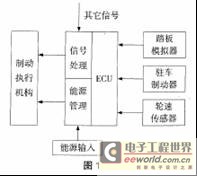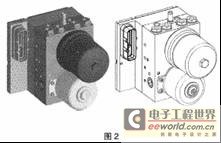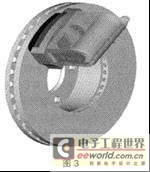Introduction to the End of Hydraulic Brake - Electronic Brake (EMB) Technology Development
As consumers pay more attention to the safety of vehicles, the vehicle brake system has undergone several changes and improvements. From the initial leather friction brakes, to the later emergence of drums, disc brakes, and later to the mechanical ABS brake system, followed by the development of electronic technology, the emergence of analog electronic ABS brake system, digital electronic control ABS brake system and more. In the past 10 years, the development of vehicle-by-wire (x-by-wire) has been developed in western developed countries. The brake-by-wire system has emerged, and the electromechanical brakes have been launched. The research, in simple terms, the electromechanical brake is to change the part that was originally driven by hydraulic or compressed air to be driven by an electric motor, thereby improving the response speed, increasing the braking efficiency, etc., and greatly simplifying the structure and reducing the assembly. And the difficulty of maintenance.
Due to the continuous improvement of braking performance requirements, the traditional hydraulic or air brake system has a large number of electronic control systems such as ABS, TCS, ESP, etc., the structure and piping arrangement become more complicated, hydraulic (air) circuit The hidden dangers of leakage have also increased, and the difficulty of assembly and maintenance has also increased. Therefore, the electromechanical brake system with relatively simple structure and reliable function integration is more and more popular. It is foreseeable that EMB will eventually replace the traditional hydraulic (air) brake, which will become the development direction of the future vehicle.
1 brake-by-wire development profile
Brake-by-wire refers to the integration of a series of intelligent brake control systems that provide the functionality of existing brake systems such as ABS, vehicle stability control, booster braking, traction control, etc., and The system is organically combined into a complete functional system. The original brake pedal is replaced by an analog generator to accept the driver's braking intention, generate and transmit brake signals to the control and actuators, and simulate feedback to the driver according to certain algorithms. Obviously, it requires a very safe and reliable structure for normal work. Its working principle is shown in Figure 1:

Due to the limitations of technological development, two forms of brake-by-wire systems have emerged:
1.1 Introduction to EHB
EHB (Electro-Hydraulic Brake) is a line-controlled hydraulic brake developed on the basis of traditional hydraulic brakes. EHB replaces the pressure regulator and ABS module in the traditional brake with a comprehensive brake module. The integrated brake module contains components such as motors, pumps, batteries, etc. It can generate and store brake pressure, and The braking torque of the four tires is individually adjusted. Compared with the traditional hydraulic brakes, EHB has made remarkable progress. Its compact structure, improved braking efficiency, convenient control and reliable braking noise are significantly reduced, no vacuum device is needed, the brake pedal is effectively relieved, and the brake pedal is provided. Good pedal feel. Due to the increased modularity, the design flexibility is increased during the vehicle design process, the number of components of the brake system is reduced, and the arrangement and space of the brake system in the vehicle are saved. It can be seen that EHB has been greatly improved compared to conventional hydraulic brakes. However, EHB still has its limitations, that is, the entire system still needs hydraulic components, and the basic is still inseparable from the brake fluid.
The emergence of EHB is mainly to lay the foundation for future research and production of EMB, and to accumulate a large amount of production experience. As early as 1993, FORD had an electric car with EHB. Later, GM also used the EHB brake system on one of its cars. It can be seen that foreign big car companies have already started research on brake-by-wire braking system. The following figure shows the structure of an EHB developed by DELPHI:

1.2 Introduction to EMB
If the EHB is referred to as a "wet" brake-by-wire brake system, then the EMB is a "dry" brake-by-wire brake system. EMB is the English abbreviation of Electromechanical Brake. The biggest difference between it and EHB and HB is that it no longer needs brake fluid and hydraulic components. The braking torque is generated entirely by the motor-driven actuator mounted on the four tires. Therefore, the brake master cylinder, hydraulic pipeline and the like are cancelled correspondingly, which can greatly simplify the structure of the brake system, facilitate the arrangement, assembly and maintenance, and more significantly, with the cancellation of the brake fluid, the environment is greatly polluted. Reduced.
In addition, since many existing components can be eliminated, the weight of the system can be greatly reduced, and the vehicle chassis can be comprehensively and actively controlled. The outstanding advantages are: no need to brake the pipeline, thus reducing the manufacturing cost and the difficulty of the installation arrangement, the braking performance is improved, the performance is stable, the brake fluid is not required to reduce the cost, the environment is protected, and the vehicle is integrated into the vehicle. In the controlled network (CAN bus), the space is reduced due to the reduced number of parts, and the pedal performance is improved because the brake pedal only provides a reference input and does not directly act on the brake system.
Since the 1990s, some well-known automotive electronic parts manufacturers such as Bosch, Siemens and ConTInentalTeves have started research on EMB electric brakes, and have done some corresponding system simulation and loading tests. As shown in the figure below is a schematic diagram of the EMB brake system developed by a German company:

2 EMB electromechanical brake system
2.1 EMB development and status quo
EMB was first applied to aircraft. For example, the US F-15 fighter used EMB brakes, and later it was slowly converted into cars. EMB is vastly different from traditional braking systems, and its execution and control mechanisms require a complete redesign. The actuator needs to be able to smoothly convert the rotation of the motor into the translation of the brake shoe, the need to be able to reduce the torque, the need to be able to automatically compensate for the brake clearance caused by long-term work, etc., and the structure must also be limited due to the volume limitation. Ingenious and compact, it is a very important part of the entire EMB system; its control part also requires precise control of the motor's speed and angle to prevent brake lock. In recent years, some international large auto parts manufacturers and automakers have carried out some research work on EMB braking systems, and applied for some patents. The main competing companies are: ConTI-nental Teves, Siemens, Bosch, Eaton, Allied. Signal, Delphi, Varity Lucas, Hayes, etc., and the domestic research on this project is basically blank. Only the relevant research work of the Second Automobile, Tsinghua University and Nanjing Aerospace University.
2.2 Structure and classification of EMB systems
For the mechanical actuator of the EMB system, it directly receives the torque generated by the motor and amplifies it to the brake disc. Its structure should meet the following basic requirements:
1) Compact structure and easy to arrange;
2) Ability to convert rotation into translation;
3) There is a mechanism for decelerating and increasing torque and self-energizing;
4) can automatically compensate the brake gap;
5) able to provide parking brake when parking;
6) Safe and reliable, and long working hours.
As mentioned above, each company has achieved its own research results and successfully applied for some patent protection. In general, EMB braking systems can be divided into two broad categories from the perspective of energy saving. One is that the electric motor directly drives the mechanical actuator and then acts on the brake disc, which is typically a brake developed by ConTInental Teves. The second type is that the motor is indirectly applied to the brake disc through a self-energizing mechanism, which can greatly reduce the energy consumed by the system. The internal data of the German Aerospace Center (DLR) shows that the company's EMB brake system eBrake is the first. One type of structure saves about 83% of energy. The brake of the first type is characterized by simple control and stable braking process; however, since the motor provides all the thrust required to push the brake block, the power of the required drive motor is large, resulting in the size and weight of the motor. The energy consumption is large. The second type of brake uses the kinetic energy of the car as the brake self-energizing force. The power required to drive the motor can be greatly reduced. Only about 3% of other alternative energy consumption is required, and its volume, size and weight are also It is inevitably smaller than the brake of the first type of structure, but currently this type of brake is difficult to control and the brake stability is not as good as the former.
2.3 Problems that EMB needs to solve
The EMB brake system is obviously superior to many conventional brake systems, but due to its short development time, there are still many problems that need to be solved:
1) How should the brake system behave if there is an open circuit or a power failure? What should I do if the brake pedal simulator fails? Therefore, research efforts on system reliability and accident insurance need to be strengthened.
2) Because of the large amount of heat generated during high-speed braking, it is necessary to enhance the thermal stability and heat dissipation performance of the system. Repeated experiments are required to verify the performance and stability of the drive motor and other components under high temperature conditions.
3) Electric brake system It is difficult to avoid a large number of electronic circuits by using a large number of electronic control technologies, and it is necessary to strengthen the resistance of the electric brake system due to the complicated working conditions of the vehicle and the work in the externally exposed electromagnetic field and the earth magnetic field environment. Interference ability.
4) The driving motor action needs to consume a lot of electric energy. This is a test for the 12v power supply used by the current vehicle. In the future, 42V voltage will be used to provide energy for the system.
5) At present, the vehicle EMB brake system should be strengthened with other existing vehicle electronic control systems. It is better to form an integrated and modular chassis_control system for comprehensive control of the vehicle.
6) Due to the large number of sensors, control chips and new technologies, the cost of the current electric brake system is higher than that of the existing hydraulic brake system. Therefore, reducing the system use cost is also a problem that needs to be solved currently.
2.4 EMB research direction
At present, the technology of EMB braking system is still immature, and there are still many technical problems to be solved. The research focus on electric braking system in foreign countries focuses on the following aspects:
1) High temperature resistant electronic components;
2) mechanical-electronic actuators;
3) control algorithm that can be adaptively adjusted;
4) Sensors with high sensitivity and low cost;
5) System fault tolerance control;
6) High reliability wires and connectors;
7) Design of torque motor.
The research on high temperature resistant electronic components mainly involves two aspects: one is to work hard on the electronic components themselves to improve their ability to withstand high temperatures and work stability at high temperatures; the other is to improve the material of the brake discs. And improve its heat dissipation. Provide a good environment for the work of electronic components.
At home and abroad, scholars at home and abroad have also done a lot of work on the control algorithms and advanced sensors of brakes. At present, there are three main control algorithms for vehicle brakes: sliding mode control algorithm, logic threshold control, and optimal control algorithm.
In the fault tolerance of electric control systems, a large number of papers have recently studied this problem. Because this problem involves the safety and reliability of the brake system, it is a key and crucial research direction. Some scholars use experimental methods to detect and evaluate the response of the EMB to the braking request, and use a certain algorithm to ignore the instantaneous error signal to achieve fault-tolerant control of the system; some are added to the distributed line control system. A brake-by-wire manager, a redundant design that is specifically designed for fault-tolerant control, with specially-written software for fault-tolerant control processing; more recently, a monitor is introduced into the system ( Monitor) to detect signals that may cause system errors and failures, then generate, error-detect code, handle failures and improve security based on code. Obviously, fault-tolerant control of vehicle electronic control system is a difficult problem that involves computer hardware, software, communication protocols and so on.
Other design and manufacturing such as connecting cables and sensors will be simpler. In addition, during the braking process, the motor will work in the harsh environment of “blockingâ€, so the reliability of the motor is high, and the structure must be compact and compact, easy to install, and can work reliably under various harsh environments. As for the mechanical actuators, quite a few companies have come out of the real thing.
3 Conclusion
It can be seen from the above that although EMB brakes have incomparable advantages and broad application prospects compared with traditional hydraulic brakes, they also have their own problems to be solved. Only by solving some key problems that restrict the development of EMB brakes, the more they can be obtained. The more widely used.
Shenzhen Jiesai Electric Co.,Ltd , https://www.gootuenergy.com